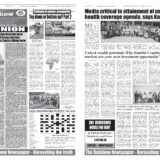Zambia signed the World Health Organization’s Framework Convention on Tobacco Control (FCTC) on Friday May 23 2008 and ratified the treaty, a legal action indicating a country’s consent to be bound by its terms, on Thursday 21st August, 2008
Notice: Undefined index: catFilterList in /home/zambi/public_html/wp-content/plugins/wp-likes/api.php on line 243
Zambia signed the World Health Organization’s Framework Convention on Tobacco Control (FCTC) on Friday May 23 2008 and ratified the treaty, a legal action indicating a country’s consent to be bound by its terms, on Thursday 21st August, 2008
The Republic of Zambia is a Lower Middle-income country in the centre of Southern Africa which shares borders with Tanzania, Democratic Republic of the Congo, Angola, Namibia, Botswana, Zimbabwe, Mozambique, and Malawi.1 Life expectancy at birth is 62.3 years and 57.3% of the 9.0 million resident adult population earn less than the international poverty line of US$1.90 per day.23
Zambia is a presidential republic. The cabinet is appointed by the president from members of the unicameral National Assembly which is comprised of 166 seats. Of these, 156 members are directly elected in single-member constituencies and nine members are appointed by the president to serve five-year terms. Major political parties include the Patriotic Front (80 seats), United Party for National Development (58 seats) and the Movement for Multi-Party Democracy (3 seats).4 In the Judicial Branch the Supreme Court is the highest court followed by the high court, magistrates courts, and local courts. Justices are appointed by the president.5
Smoking in Zambia
The 2017 World Health Organization STEPwise approach to surveillance (STEPS) survey found the prevalence of smoking to be 23.0% in men and 2.0% in women.6 This is an increase on earlier prevalence estimates, although the methodologies of previous prevalence surveys differ.7 The number of tobacco-related deaths in Zambia also increased from an estimated 3,000 per year (43 per 100,000) in 1990 to 8,000 per year (46 per 100,000) in 2015.8
Tobacco in Zambia
According to WHO estimates, Zambia is among the top five tobacco leaf growing countries in Africa and accounted for 9.7% of tobacco leaf production in Africa in 2012.9 Consecutive Zambian National Development Plans have empahsised the importance of tobacco production to the Zambian economy.1011 The agricultural land devoted to the harvesting of tobacco in Zambia increased 1,908% between 1996 and 2016 and the export quantity increased by nearly 800% in the same period.12 Accordingly, the value of the export of tobacco leaf has increased from US$1.4 million in 1995 to US$139.9 million in 2016.
In addition to being an important tobacco growing country, Zambia is also moving towards greater capacity for the processing of tobacco leaf and manufacturing of tobacco products. In 2018, British American Tobacco Zambia and Roland Imperial Tobacco opened cigarette-manufacturing facilities in the Lusaka Multi-Facility Economic Zone.13 They report capability of producing over 20 million cigarettes daily aimed at both the export and domestic markets. A company profile for Roland said:14
“The factory now has an installed capacity to produce 21,000 cigarettes per minute, with a running time of 15 hours per day. The state of the art of machinery, sourced from the manufacturers of the best and robust cigarette manufacturing equipment in the world, has a capacity of seven billion cigarettes per annum.”
In parallel with the increased manufacturing capacity, factory-made cigarettes are becoming more affordable in Zambia.15 Estimates from the Economist Intelligence Unit showed the inflation-adjusted price of factory-made cigarettes had nearly halved between 2002 and 2016.16 In the International Tobacco Control (ITC) Zambia, only 27% of male smokers and quitters reported that the price of cigarettes led them to think about quitting.17 Furthermore, in stark contrast with the WHO recommended 75% tax share, in 2016 Zambia’s tax comprised only 37% of the retail price of cigarettes of the most popular brand, compared with the 56% global average.18
Roadmap to Tobacco Control
Laws and regulations relating to Tobacco in Zambia date back to the Tobacco Levy (no 64 of 1967, amended to Act No. 13 of 1994).19 In December 1992, the Public Health (Tobacco) Regulations (Statutory Instrument No. 163 of 1992) of the Public Health Act (Laws, Volume XI. Cap.535) banned sales to minors under the age of 16, product giveaways and pro-tobacco advertising in the media.20 Further regulations included a ban on smoking in various public places (including government buildings, private worksites, educational facilities, healthcare facilities and public transport) and text-based tobacco labelling regulations of tobacco products.
Zambia signed the World Health Organization’s Framework Convention on Tobacco Control (FCTC) on May 23 2008 and ratified the treaty, a legal action indicating a country’s consent to be bound by its terms, on August 21 2008.21 In April 2008, the Local Government (Prohibition of Smoking in Public Place) Regulations (Statutory Instrument No. 39 of 2008) of The Local Government Act (Laws, Volume 16, Cap 281) banned smoking in all public places.22 However the regulations listed above failed to comply with the FCTC and several reports highlight the lack of effective enforcement of these legal frameworks.232425
Zambia Tobacco and Nicotine Products Control Bill
The Zambia Tobacco and Nicotine Products Control Bill was first drafted in 2010 but was deemed to require further revision and consultations during a “consensus building” process with stakeholders.26 This delayed the bill going to cabinet. During the consultations some areas of the bill were revised to include provision for measures not in line with the FCTC, including designated smoking areas and smoking rooms. The revised consensus document was taken to cabinet by the Minister of Health but faced further criticism and was taken no further.27
The Zambia Tobacco and Nicotine Products Control Bill 2018 developed from a redrafting of the 2010 bill for FCTC compliance. A Committee on the implementation of the WHO-FCTC was formed in April 2017 incorporating representatives from across government departments.28 A Joint Needs Assessment for Tobacco Control was conducted in November 2017, by the Ministry of Health and the Convention Secretariat to identify potential constraints to full implementation of the FCTC and presented to the Ministry of Health in June 2018. This was followed by the drafting of the Zambia Tobacco and Nicotine Products Control Bill 2018.29 The bill is currently undergoing a consultation process and is expected to be presented to Parliament in 2019.
On 18th June 2019, as part of the consultation process, the Zambia Chamber of Commerce and Industry (ZACCI) presented a series of presentations to Ministries opposing the measures proposed in the bill. ZACCI are a membership organisation whose activities including lobbying the Zambian government.30 ZACCI state that their members “…have the opportunity to comment government’s plans in a very early stage and influence plans in their favour.”31 Their members include the three major tobacco companies in the region; British American Tobacco, Japan Tobacco International, and Roland Imperial Tobacco. They have previously partnered with the British American Tobacco on tobacco industry funded corporate social responsibility campaigns in Zambia.32
References
- ↑World Bank, Zambia overview, 2019, accessed May 2019
- ↑United Nations Development Programme, Human Development Reports: Zambia, 2019, accessed May 2019
- ↑World Bank, Data: Population, total: Zambia, 2019, accessed May 2019
- ↑Encyclopaedia Britannica Zambia: Government and Society, 2019, accessed May 2019
- ↑Judiciary of Zambia Court Structure, 2019, accessed May 2019
- ↑World Health Organization, SURVEY Zambia-fact-sheet.pdf Zambia STEPS Survey 2017: Fact Sheet, 2017, accessed May 2019
- ↑The International Tobacco Control Policy Evaluation Project, . ITC Zambia National Report Findings from the Wave 1 and 2 Surveys (2012-2014), 2015, accessed May 2019
- ↑Global Burden of Disease 2015 Tobacco Collaborators, Smoking prevalence and attributable disease burden in 195 countries and territories, 1990-2015: a systematic analysis from the Global Burden of Disease Study 2015., The Lancet, 2017,389(10082):1885-906, accessed May 2019
- ↑World Health Organization, Status of Tobacco Production and Trade in Africa, 2015, accessed May 2019
- ↑R. Labonte, R. Lencucha, J. Drope, C. Packer, FM. Goma, R. Zulu, The institutional context of tobacco production in Zambia, Global Health, 2018,16;14(1):5, accessed May 2019
- ↑Ministry of National Development Planning, Seventh National Development Plan 2017-2021, 2017, accessed May 2019
- ↑Food and Agriculture Organization of the United Nations, FAOSTAT: Data: Production, crops. Zambia, 2019, accessed May 2019
- ↑British America Tobacco constructs a $ 25million cigarette plant, Lusaka Times, 13 October 2018, accessed May 2019
- ↑Roland Imperial Tobacco Company LTD Roland Imperial Tobacco: Company Profile , 2018, accessed May 2019
- ↑M. Stoklosa, F. Goma, N. Nargis, J. Drope, G. Chelwa, Z. Chisha, GT. Fong, Price, tax and tobacco product substitution in Zambia, Tobacco Control, 2018,28(Suppl 1):s45-s52. accessed May 2019
- ↑Economist Intelligence Unit, World Cost of Living Survey 2017, 2017, accessed may 2019
- ↑The International Tobacco Control Policy Evaluation Project, . ITC Zambia National Report Findings from the Wave 1 and 2 Surveys (2012-2014), 2015, accessed May 2019
- ↑World Health Organization, World Health Organization report on the global tobacco epidemic 2017, 2017, accessed May 2019
- ↑Government of the Republic of Zambia, The Tobacco Act. In: The Laws of Zambia, 1967, accessed May 2019
- ↑Government of the Republic of Zambia, Public Health (Tobacco) Regulations (Statutory Instrument No. 163 of 1992). In: Public Health Act (Laws, Volume XI Cap535), 1992, accessed May 2019
- ↑The Framework Convention Alliance, Ratifications/accessions in chronological order, 2019, accessed May 2019
- ↑The Government of the Republic of Zambia, The Local Government (Prohibition of Smoking in Public Places) Regulations, 2008 (Statutory Instrument No. 39 of 2008). In: The Local Government Act (Laws, Volume 16, Cap 281), 2008, accessed May 2019
- ↑F. Goma, M.Ililonga, J. Drope, Zambia, In: Tobacco Control in Africa, 2012, 262-84, accessed May 2019
- ↑R. Labonte, R. Lencucha, FM. Goma, R. Zulu, J. Drope, Consequences of policy incoherence: how Zambia’s post-FCTC investment policy stimulated tobacco production, Journal of Public Health Policy, 2019, accessed May 2019
- ↑International Tobacco Control (ITC) Policy Evaluation Project, Zambia Tobacco Control Action is Ineffective in Reducing Tobacco Use, 2015, accessed May 2019
- ↑World Health Organization Regional Office for Africa, WHO/AFRO supports advocacy and orientation meetings on implementation of the WHO Framework Convention on Tobacco Control in Zambia, 2017, accessed May 2019
- ↑Professor F. Goma (University of Zambia), Personal interview by Bath Tobacco Control Research Group staff, May 7 2019
- ↑United Nations Interagency Task Force on NCDs, Zambia: NCD Joint Programming mission, 2018, accessed May 2019
- ↑World Health Organization Regional Office for Africa, WHO and the Ministry of Health engage Parliamentarians to discuss their support and contribution to the WHO Framework Convention on Tobacco Control, 2018, accessed May 2019
- ↑Zambia Chamber of Commerce and Industry (ZACCI), accessed July 2019
- ↑Zambia Chamber of Commerce and Industry, Advocacy, accessed July 2019
- ↑Lusaka Star BAT, ZACCI LAUNCHES UNDERAGE SMOKING AWARENESS CAMPAIGN, 1 Feb 2019, accessed July 2019























